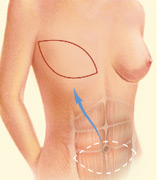Breast Cancer Part 3: Reconstruction Choices
Take Time to Make the Right Decisions
If you are diagnosed with breast cancer, you have many choices to make. Take the time to make the right ones. Immediate reconstruction is safe, but you are not necessarily burning any bridges by delaying your reconstruction for personal reasons. No matter what your choice, breast reconstruction is inherently staged. This means it will involve multiple procedures, each being one of the stages, to achieve an optimal outcome. Breast reconstruction generally falls into two categories: implant reconstruction or reconstruction using a persons own tissue, also known as autologous reconstruction. Autologous reconstruction can be subdivided into either flap reconstruction, reconstruction with autologous fat transfer or even a combination of the two. All breast surgery will leave visible scars on the chest and although breast reconstruction will rebuild your breasts, the results are variable. Your reconstructed breast(s) will always feel different from your natural breast.
Last week we took closer look at breast reconstruction with autologous fat transfer. This week we will continue our educational series by discussing autologous reconstruction with flap techniques.
Flap Techniques
Flap techniques surgically reposition your own skin, fat and muscle to reconstruct your breast(s). Donor sites are areas of your body (abdomen, back, buttocks) where the surgeon harvests skin, fat and muscle for reconstruction. The hospital stay is usually two to five days with a recovery time of several weeks to months. These procedures offer a more natural appearance and feel than that of an implant. However, losing the muscle or part of the muscle from a donor site may leave a residual permanent weakness at that site (abdomen and/or back). You will be left with scars on your chest and another part of your body (abdomen, back or buttocks). Your reconstructed breasts will feel and look more natural but they will not be sensate.
Advances in microsurgical techniques have made free flap procedures available to patients desiring autologous reconstruction. The muscles are preserved during these procedures, therefore reducing the risks of donor site complications and permanent donor site weakness. However, these are lengthy surgeries, requiring specialized expertise in microsurgery and should only be carried out at facilities experienced with the postoperative care of free flaps. Otherwise the morbidity, complication and failure rates can be very high. Flap reconstruction procedures frequently require additional procedures to achieve the final breast contour and symmetry.
Each reconstructive technique has pros and cons. Join us for our next blog about breast reconstruction with implants. Please click here to read previous series Part 1, Part 2.
Diagram courtesy of American Society of Plastic Surgeons

